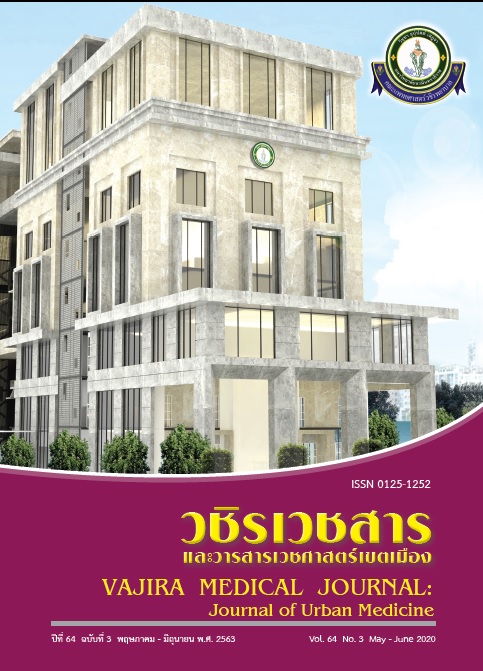The Effect of Damper on Tennis Racket Handle Impact Force after Ball Impaction
Main Article Content
Abstract
Objective: To compare the peak force and vibration at tennis racket grip between different dampers and different tennis ball impact locations.
Methods: The peak force and vibration was measured at tennis rackets grips between 4 different damping conditions which were no damper, button damper, rubber band damper and worm damper. Tennis balls were served using a tennis strike-simulating machine with speed 32m/s. The peak force were recorded from a wireless force transducer attached to the grip during four locations on string bed: center, above center, below center, and off-axis. Vibration was calculated form time domian using Fourier transform.
Results: At a below center impact location, the button damper yielded a 10% reduction in some harmonic of the racket’s vibration from 191.7 ± 2.6 Hz to 172.9 ± 2.8 Hz (p =0.001), the rubber band damper yielded a 8% reduction from 191.7 ± 2.6 Hz to 176.8 ± 4.4 Hz (p = 0.005), whereas the worm damper yielded a 7% reduction from 191.7 ± 2.6 Hz to 178.8 ± 3.8 Hz (p = 0.011). No significant effect of damper types on the vibration with the others impacts location. These dampers did not reduce the impact force at the grip regardless of the location.
Conclusion: Damper reduced the racket’s vibration when the ball impacts a below center position.
Downloads
Article Details
References
Abrams GD, Renstrom PA, Safran MR. Epidemiology of musculoskeletal injury in the tennis player. Br J Sports Med 2012;46:492-8.
Sell K, Hainline B, Yorio M, Kovacs M. Injury trend analysis from the US Open Tennis Championships between 1994 and 2009. Br J Sports Med 2014;48:546-51.
Dines JS, Bedi A, Williams PN, Dodson CC, Ellenbecker TS, Altchek DW, et al. Tennis injuries: epidemiology, pathophysiology, and treatment. J Am Acad Orthop Surg 2015;23:181-9.
De Smedt T, de Jong A, Van Leemput W, Lieven D, Van Glabbeek F. Lateral epicondylitis in tennis: update on aetiology, biomechanics and treatment. Br J Sports Med 2007;41:816-9.
Martin C, Bideau B, Ropars M, Delamarche P, Kulpa R. Upper limb joint kinetic analysis during tennis serve: Assessment of competitive level on efficiency and injury risks. Scand J Med Sci Sports 2014;24:700-7.
Groppel JL, Nirschl RP. A mechanical and electromyographical analysis of the effects of various joint counterforce braces on the tennis player. Am J Sports Med 1986;14:195-200.
Rompe JD, Decking J, Schoellner C, Theis C. Repetitive low-energy shock wave treatment for chronic lateral epicondylitis in tennis players. Am J Sports Med 2004;32:734-43.
Cross R. Factors affecting the vibration of tennis racquets. Sports Engineering 2015;18:135-47.
Ghada M. El-hafez and Amira A. A. Abdalla Mariam A. A. Ameer SME-h. Effect of String Vibration Damper of Tennis Racket on Myoelectric Activity of Wrist Extensors. Int J Curr Res 2015;7:14656-61.
Timme N, Morrison A. The mode shapes of a tennis racket and the effects of vibration dampers on those mode shapes. J Acoust Soc Am 2009;125:3650-6.
Stroede CL, Noble L, Walker HS. The effect of tennis racket string vibration dampers on racket handle vibrations and discomfort following impacts. J Sports Sci 1999;17:379-85.
Li F, Fewtrell D, Jenkins M. String vibration dampers do not reduce racket frame vibration transfer to the forearm. J Sports Sci 2004;22:1041-52.
Mohr S, Cottey R, Lau D, Gillet C, Kotze J, Jolly M, et al. Dynamics of a String-Bed Damper on Tennis Rackets (P175). The Engineering of Sport 7: Springer; 2008. p. 179-89.
Duane V. Factors affecting force loading on the hand in the tennis forehand. J Sports Med Phys Fitness 1991;31:527-31.
Wei S-H, Chiang J-Y, Shiang T-Y, Chang H-Y. Comparison of shock transmission and forearm electromyography between experienced and recreational tennis players during backhand strokes. Clin J Sport Med 2006;16:129-35.
Naß D, Hennig EM, Schnabel G, editors. Ball impact location on a tennis racket head and its influence on ball speed, arm shock and vibration. ISBS-Conference Proceedings Archive; 1998.
Li L, Yang SH, Hwang C-S, Kim YS. Effects of string tension and impact location on tennis playing. J Mech Sci Technol 2009;23:2990-7.
Chow JW, Carlton LG, Lim YT, Chae WS, Shim JH, Kuenster AF, et al. Comparing the pre- and post-impact ball and racquet kinematics of elite tennis players’ first and second serves: a preliminary study. J Sports Sci 2003;21:529-37.
Hennig EM, Rosenbaum D, Milani TL. Transfer of tennis racket vibrations onto the human forearm. Med Sci Sports Exerc 1992;24:1134-40.
Mohandhas BR, Makaram N, Drew TS, Wang W, Arnold GP, Abboud RJ. Racquet string tension directly affects force experienced at the elbow: implications for the development of lateral epicondylitis in tennis players. Shoulder Elbow 2016;8:184-91.
Hatze H. Forces and duration of impact, and grip tightness during the tennis stroke. Med Sci Sports 1976;8:88-95.
Englel J. Tennis: Dynamics of racket-grip interaction. J Hand Surg 1995;20:S77-S81.
Porramatikul M, Meeopartmongkon T. Effect of tennis racket damper on the peak force and damping time. Journal of the Medical Association of Thailand. 2018;101:S31-S6.
Pavilas C, Chaiwatcharaporn C. Comparision in maximum ball velocity of 3-structural characteristic rackets using simulated tennis flat serve. J Sports Sci 2014;14.


